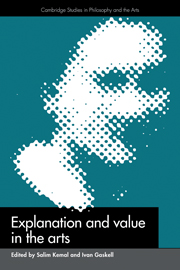Book contents
- Frontmatter
- Contents
- List of contributors
- Editors' acknowledgments
- 1 Interests, values, and explanations
- 2 Fiction and reality in painting
- 3 Franz Kafka: the necessity for a philosophical interpretation of his work
- 4 On relocating ethical criticism
- 5 Explanation and value: what makes the visual arts so different, so appealing?
- 6 Is art history?
- 7 Objectivity and valuation in contemporary art history
- 8 Fullness and parsimony: notes on creativity in the arts
- 9 Principles of a sociology of cultural works
- 10 Althusser and ideological criticism of the arts
- 11 Film, rhetoric, and ideology
- Index
1 - Interests, values, and explanations
Published online by Cambridge University Press: 24 February 2010
- Frontmatter
- Contents
- List of contributors
- Editors' acknowledgments
- 1 Interests, values, and explanations
- 2 Fiction and reality in painting
- 3 Franz Kafka: the necessity for a philosophical interpretation of his work
- 4 On relocating ethical criticism
- 5 Explanation and value: what makes the visual arts so different, so appealing?
- 6 Is art history?
- 7 Objectivity and valuation in contemporary art history
- 8 Fullness and parsimony: notes on creativity in the arts
- 9 Principles of a sociology of cultural works
- 10 Althusser and ideological criticism of the arts
- 11 Film, rhetoric, and ideology
- Index
Summary
Paintings, novels, and poems represent objects or describe events by giving order to material that is itself of visual or literary interest: the objects and events become available through the medium in which they are formulated. The visual interest of Matisse's La fênetre ouverte lies in part in its combination of lines and colours that eschew the natural spectrum to represent a sunlit window, or the literary interest of Auden's “In Praise of Limestone” depends on its language fusing private sensibility to natural formations.
The aesthetic valuation of fine arts does not occlude these interests since visual and literary interests can serve other purposes. Botanical illustrations and engineering drawings use visually interesting material to make clear the important features of plants or clarify the dynamical relations between parts of constructions. Moreover, the conception of aesthetic value is itself at issue. Even in the eighteenth century, when it was grasped by exercising taste, this faculty appears to have so varied with changes in arrangements for displaying and distributing works that aesthetic evaluation was difficult to distinguish from evaluation of other kinds. Consonantly, contemporary art historians may examine aesthetically valuable works, but art history also gives stature to works for their iconography, context, their psychological depth, what they reveal of the history of production, the psychology of artists, and the pathology of societies – where the latter can go to explain the visual interests of works.
The salience of visual or literary interests points in two directions, one internal to a work and the other external, though not necessarily as an irresolvable bifurcation.
- Type
- Chapter
- Information
- Explanation and Value in the Arts , pp. 1 - 42Publisher: Cambridge University PressPrint publication year: 1993

